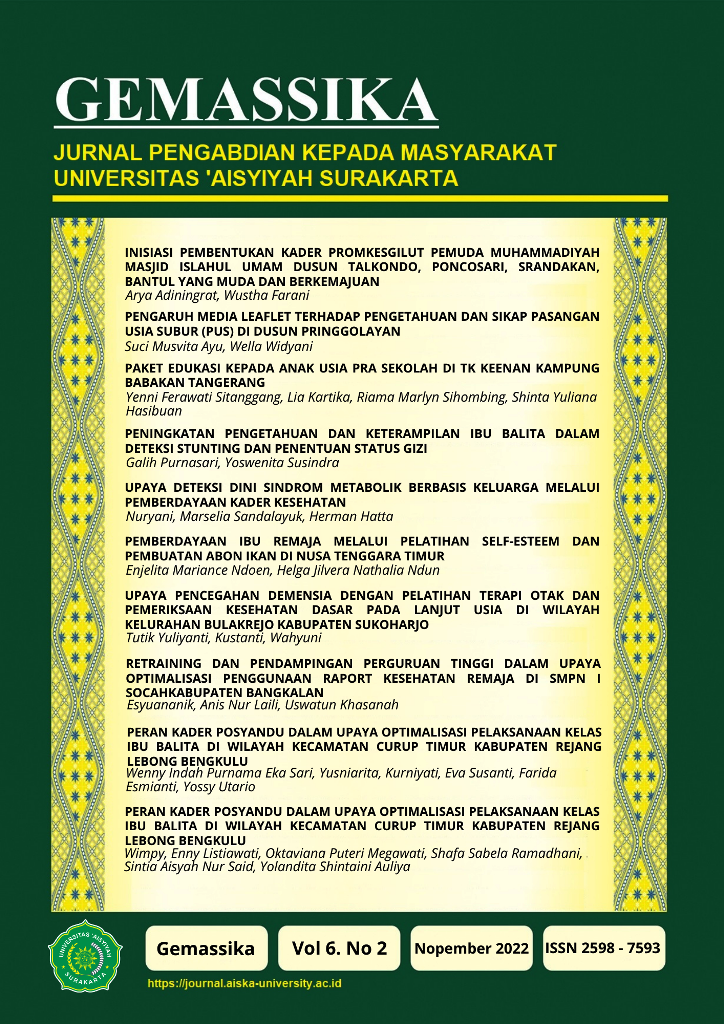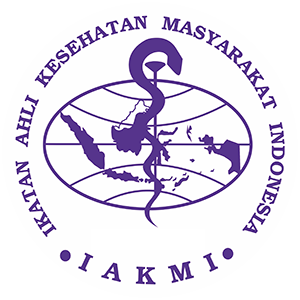UPAYA DETEKSI DINI SINDROM METABOLIK BERBASIS KELUARGA MELALUI PEMBERDAYAAN KADER KESEHATAN
DOI:
https://doi.org/10.30787/gemassika.v6i2.605Keywords:
health cadre, risk factors, metabolic syndromeAbstract
The incidence of non communicable disease (NCD) such as heart disease, diabetes mellitus, stroke, chronic kidney desease, and obesity in Gorontalo tends to be increase, which is above the national prevalence. The predisposition of NCD generally identified from the incidence of metabolic syndrome which is characterized by obesity, increased triglycerides and blood glucose, low high density lipoprotein (HDL) and hypertension. Metabolic syndrom can increase the incidence of morbidity and mortality due to vascular disease. Early detection the risk of metabolic syndrome can be done through empowering health cadres in carrying out a family based approach in the community. So that the progression of metabolic syndrome can be prevent towards NCD disease. The aim of training health cadres is (1) increasing the role of health cadres in improving health status (2) increasing the abilities and skills of health cadres in identifying risk factors for metabolic syndrome. Implementation of activities in the form of delivering material with lecture methods, interactive discussions and direct practice. The media used in this training was power points, modules and a few materials to support the practice of measuring blood pressure, nutritional status base on body mass index, blood glucose and cholesterol profile. Evaluation of activities using a questionnaire before and after training. The results was indicated an increase in the knowledge and skills of health cadres after attending the training.References
Bantas K, Yosef HK, Moelyono B. Perbedaan Gender pada Kejadian Sindrom Metabolik pada Penduduk Perkotaan di Indonesia. Jurnal Kesehatan Masyarakat Nasional. 2012: 7(5); 219 – 226.
Dieny FF, Widyastuti N, Fitranti DY. Sindrom metabolik pada remaja obes: prevalensi dan hubungannya dengan kualitas diet. Jurnal gizi klinik Indonesia. 2015: 12 (1); 1 – 11
Djausal AN. Effect of central obesity as risk factor of metabolic syndrome. J Majority. 2015: 4(3); 19 – 22.
Kementerian Kesehatan RI. Hasil Riset Kesehatan Dasar (Riskesdas) 2018. Jakarta: Kemetenrian Kesehatan RI; 2018.
Kemenkes RI. 2019. Peraturan Menteri Kesehatan Republik Indonesia Nomor 28 Tahun 2019 tentang angka kecukupan gizi yang dianjurkan untuk masyarakat Indonesia. Kemenkes RI. Jakarta.
Miller B and Fridline M. Metabolic Syndrome Prevalence and Risk in the United States based on NHANES 2001-2012 Data. J Metabolic Synd. 2016: 5(2); 1 – 6.
Nuryani dan Paramata Y. Analisis faktor risiko kejadian sindrom metabolik pada kelompok dewasa di wilayah kerja Puskesmas Telaga Biru. Laporan kemajuan penelitian dosen pemula. Universitas Gorontalo. 2019.
Saifuddin, 2014, Pengelolaan pembelajaran teoritis dan praktis, Deepublish, Yogyakarta, 128- 145.
Saklayen MG. The global epidemic of the metabolic syndrome. Current hypertention reports. 2018: 20(12);1 – 8.
Zhao Y, Yan H, Yang R, Li Q, Dang S, Wang Y. Prevalence and Determinants of Metabolic Syndrome among Adults in a Rural Area of Northwest China. Plos one. 2014: 9(3) ; 1 – 12.
Downloads
Published
How to Cite
Issue
Section
License
Copyright (c) 2022 GEMASSIKA : Jurnal Pengabdian Kepada Masyarakat

This work is licensed under a Creative Commons Attribution-NonCommercial 4.0 International License.












